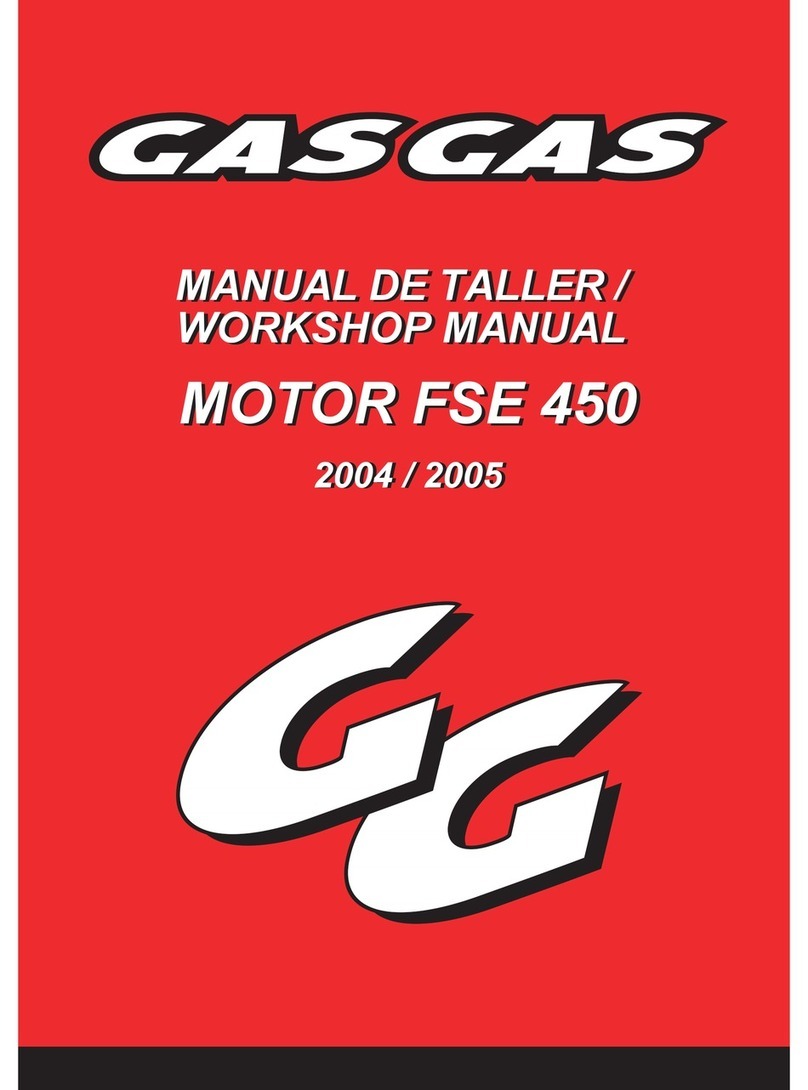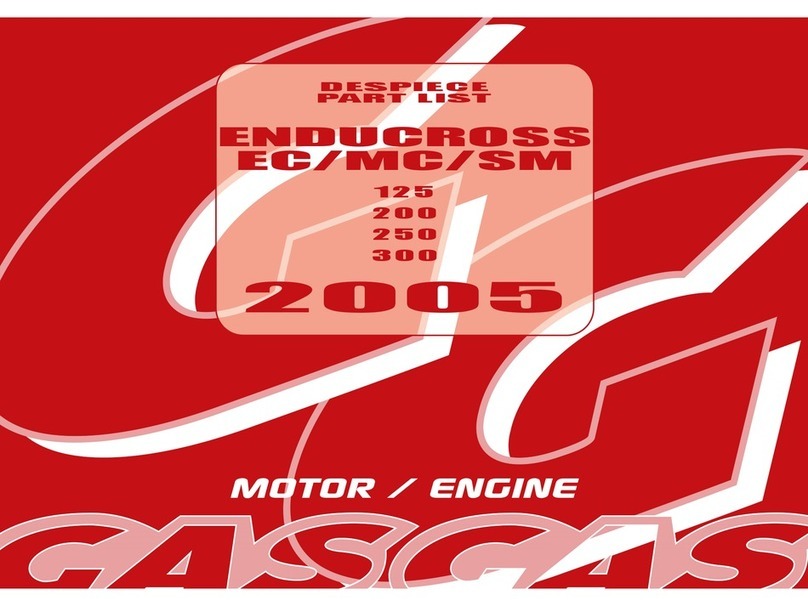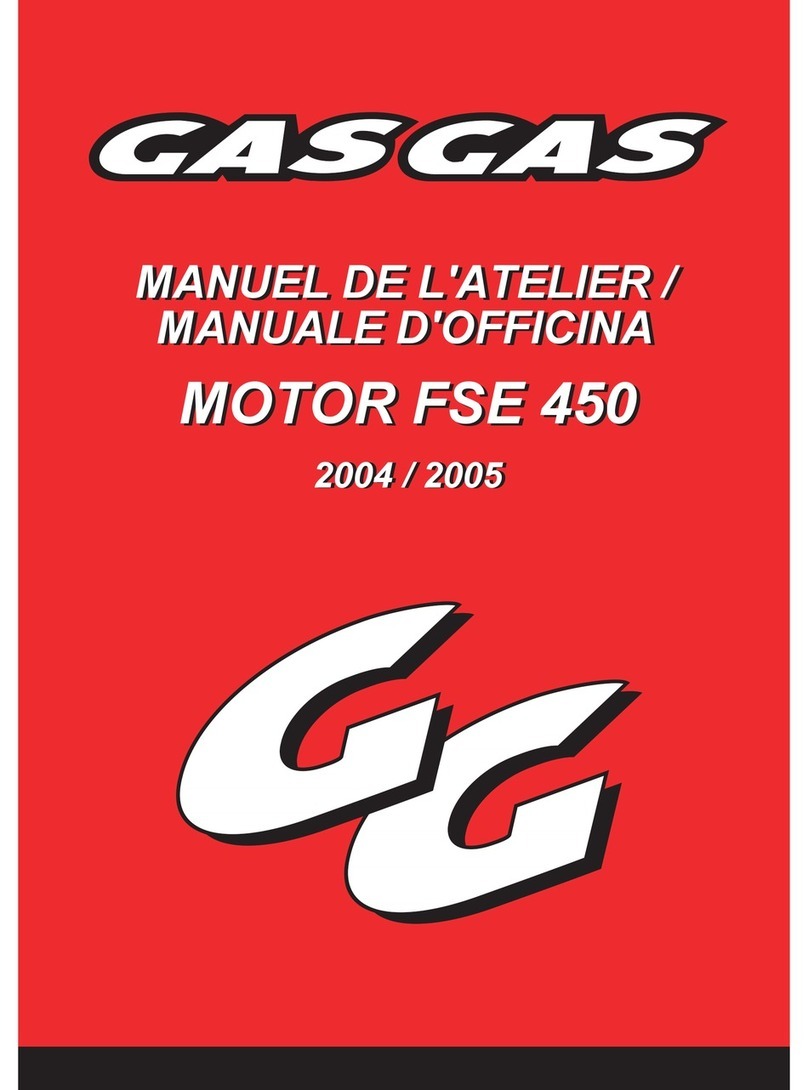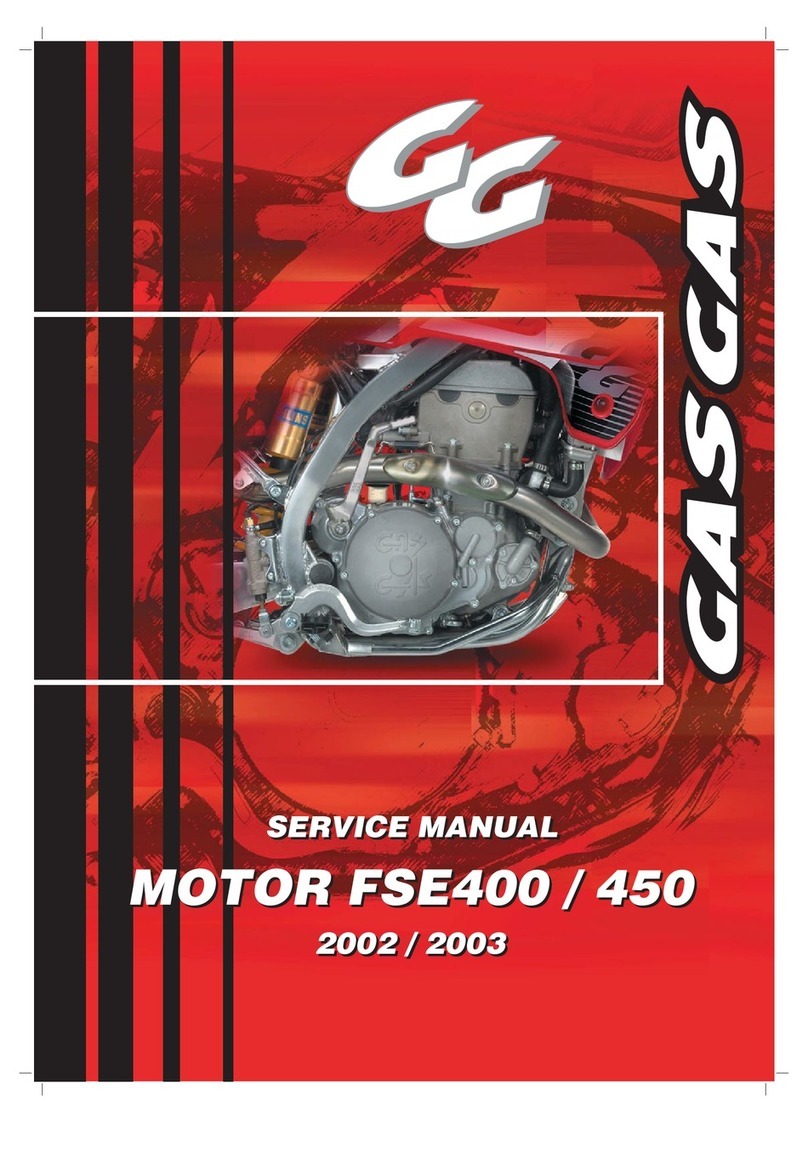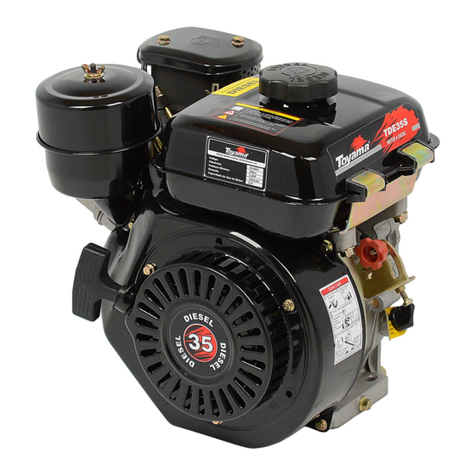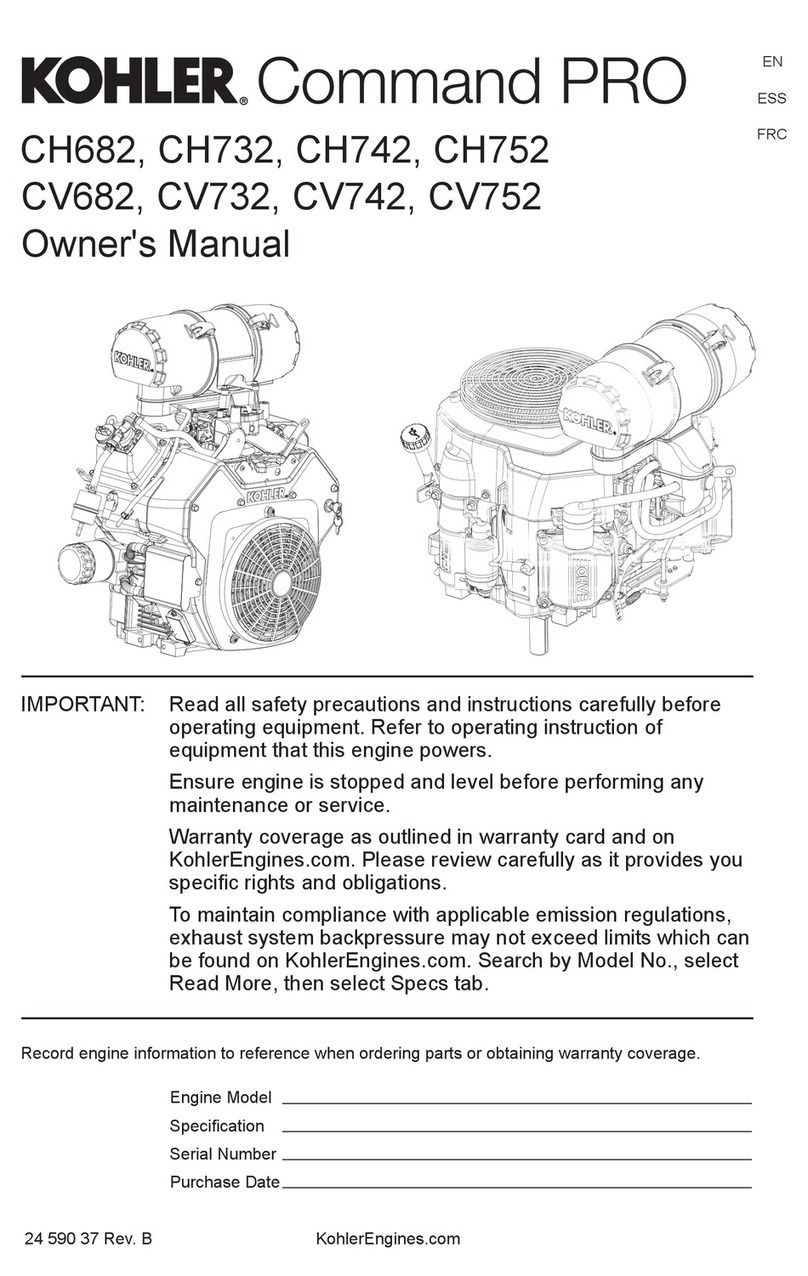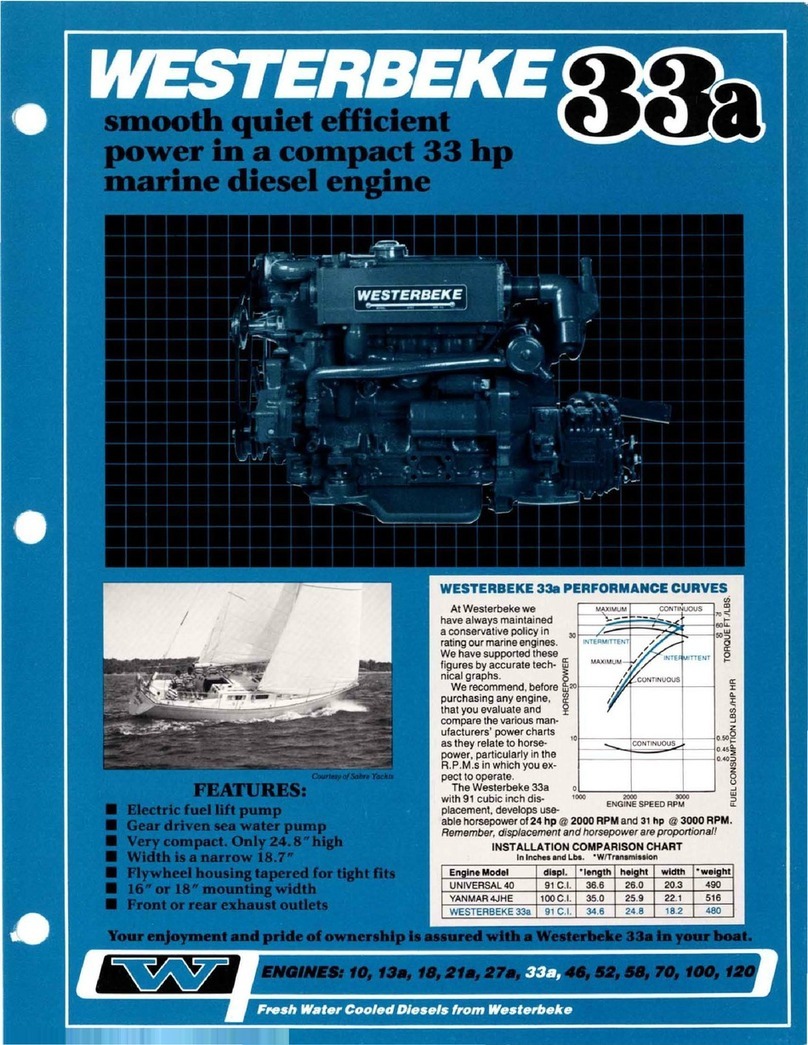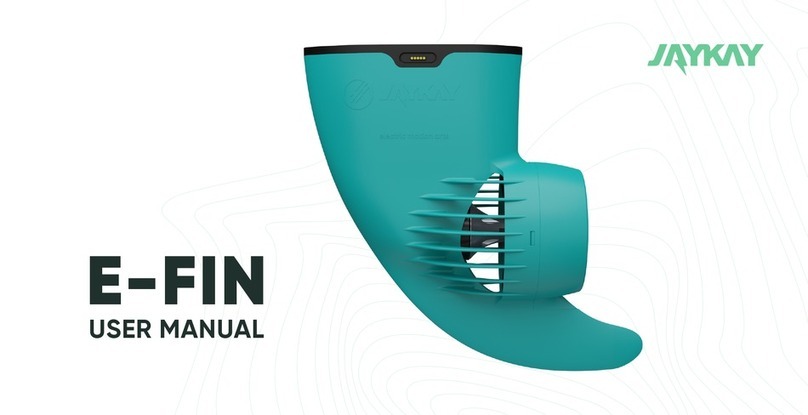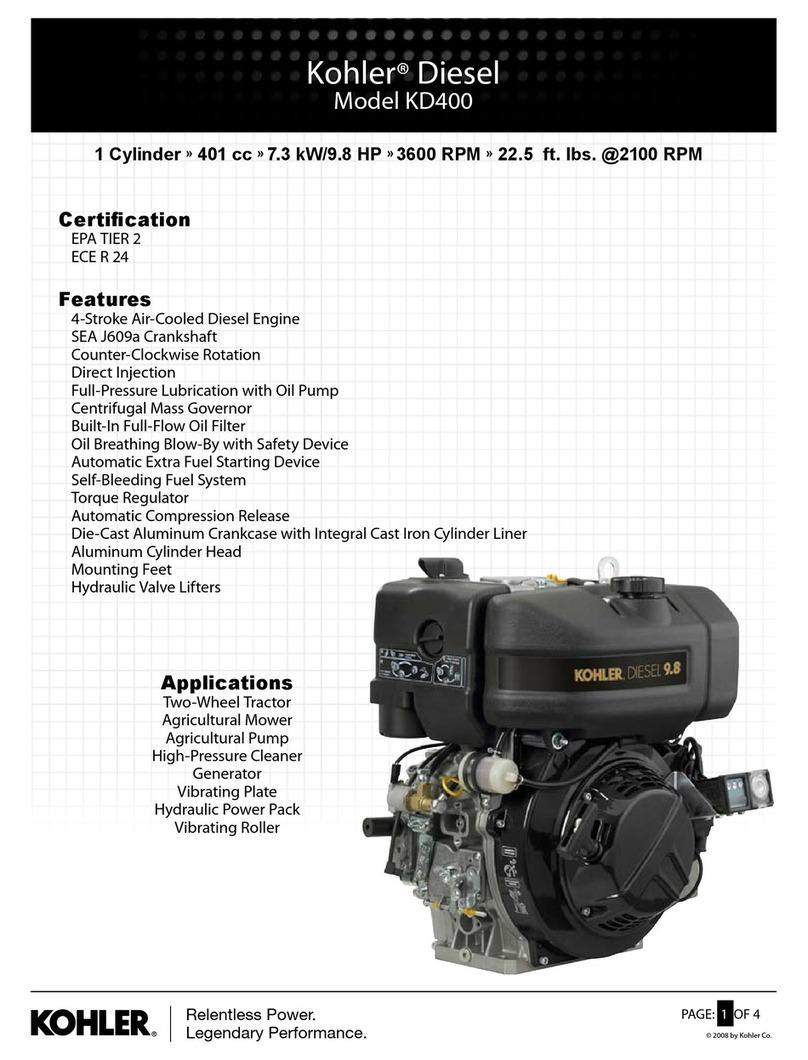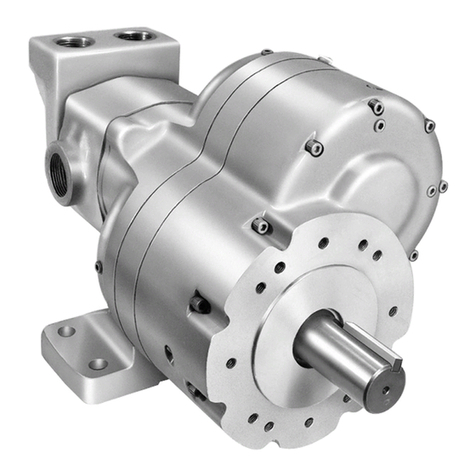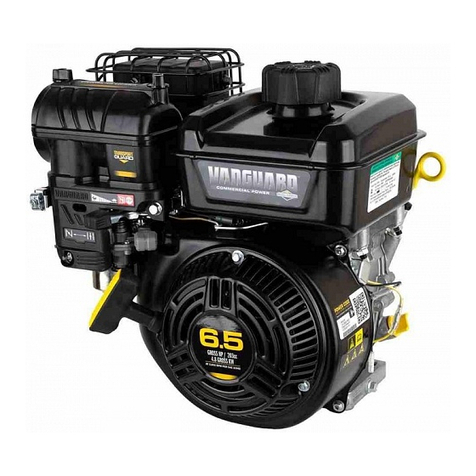GAS GAS EC 200 Instruction manual

WORKSHOP MANUAL /
WERKSTATTHANDBUCH
200 / 250 / 300
200 / 250 / 300
MOTOR EC Enducross
MOTOR EC Enducross
WORKSHOP MANUAL /
WERKSTATTHANDBUCH


INTRODUCTION
This manual was created by GAS GAS Motos, S.A. for the use of official GAS GAS services. It is principally
directed at operators with a basic knowledge of the principles of mechanics and repair techniques. It contains
precise instructions for making all the repairs, in addition to the necessary technical data to carry out the
maintenance of the motorbikes.
There is also considerable information about the special GAS GAS tools and equipment that will be of great
help in optimising repair processes.
In successive editions, we will keep you informed of all the updates and evolution of the motorbikes in this
family.
Particularly important information in the manual is preceded by one of the following symbols.
Note: indicates points of particular interest for more efficient and convenient operation.
Warning: indicates special instructions or procedures which should be followed to the letter
to avoid damaging the equipment.
Danger: indicates special instructions or procedures which must be followed to the letter to
avoid physical injury to the operators.
GAS GAS Motos, S.A
I
i
!
!


CONTENTS
Sect. P.
IV GENERAL INFORMATION
VI TABLE OF TECHNICAL DATA
01 01 REMOVING THE ENGINE FROM THE CHASSIS
02 01 FITTING THE ENGINE ON THE CHASSIS
03 01 DISMOUNTING ENGINE
04 01 SERVICE AND REPAIR OF THE ENGINE COMPONENTS
05 01 ASSEMBLING THE ENGINE
CONTENTS
Sect. P.
IV GENERAL INFORMATION
VI TABLE OF TECHNICAL DATA
01 01 REMOVING THE ENGINE FROM THE CHASSIS
02 01 FITTING THE ENGINE ON THE CHASSIS
03 01 DISMOUNTING ENGINE
04 01 SERVICE AND REPAIR OF THE ENGINE COMPONENTS
05 01 ASSEMBLING THE ENGINE
06 01 ELECTRICAL SCHEMAS
III

GENERAL INFORMATION
Certain safety and maintenance norms should be remembered when carrying out repairs to the vehicles. Some
of the more important norms are listed below:
Safety
- Do not smoke or cause sparks or naked flames in the work area. Petrol is highly inflammable and may be
explosive in certain conditions.
- Use cleaning products appropriate to each task, ensuring that they have been approved.
- Always wear protective eye equipment when using electric tools such as drills, sanders or grinders.
- Apply a protective hand cream before commencing dismantling work. This protects the skin from infection
and makes subsequent cleaning easier. Ensure that hands are not slippery.
- Remember that prolonged contact of the skin with engine oil can be damaging to health.
- Keep loose clothing away from moving parts.
- Do not wear rings, wristwatches, etc while working on the engine, especially the electrical system.
- Keep the work area tidy, it is easy to trip over elements left on the floor.
- Avoid leaving oils, grease or other fluids on the floor of the work area to avoid slipping on them.
- Use suitable tools for compressing or decompressing springs to prevent these from escaping suddenly.
- Take special care not to inhale dust from parts containing asbestos (for example: clutch discs), this product
is extremely dangerous for your health.
- Avoid inhaling fumes from petrol or cleaning fluids, these can be highly toxic. Ensure that the work area is
well-ventilated.
Maintenance
- Always use original GAS GAS spare parts and lubricants recommended by the manufacturer. Other spare
parts may damage the engine.
- Only use the tools specified for this vehicle.
- Always replace all the gaskets, seals and O-rings during service and assembly.
- After dismounting, clean components with non-inflammable dissolvent.
- Lubricate all work surfaces before assembly, except the conical couplings.
- Oil all the paired parts and bearings when assembling.
- When removing, servicing and assembling parts, only use metric-sized tools. Metric screws, nuts and bolts
are not interchangeable with parts with Imperial measurements.
- All the surfaces receiving gaskets, seals and O-rings must be carefully cleaned.
- Carefully examine all the circlips before assembly and replace any which are damaged. Always replace the
piston pin circlip after each use.
- After assembly check all the components are correctly fitted and the mechanisms are working perfectly.
IV

General tightening torques
The following table specifies tightening torques for nuts or bolts with ISO threads.
Tightening torques for components or special units are given in the relevant repair process described in this
manual.
To avoid damage, tighten units with various nuts or bolts progressively and in diagonal or alternate pairs, until
obtaining the specified torque.
To apply the tightening torques described below, clean, dry threads are necessary. Components should be at
room temperature.
*A: Distance between the nut faces.
*B: External diameter of screw thread.
Engine serial number
The engine serial number is stamped on the lower part of the left crankcase.
Remember to quote the engine serial number each time you place an order for an original GAS GAS spare
part for said engine.
*(A) NUT *(B) BOLT GENERAL TIGHTENING TORQUES
Nm
6
15
30
55
85
130
Ft.lb
4,3
11
22
40
61
94
Kgf.m
0,6
1,5
3,0
5,5
8,5
13,0
10 mm
12 mm
14 mm
17 mm
19 mm
22 mm
6 mm
8 mm
10 mm
12 mm
14 mm
26 mm
V

TABLE OF TECHNICAL DATA
Engine
Definition Mono-cylindrical 2-stroke engine, liquid-cooled, intake to crankcase
Displacement in cubic centimetres 200 Engine: 199.4cc
250 Engine: 249.3cc
300 Engine: 294.7cc
Fuel RON / SUPER-LEAD-FREE 95-98 octane.
Mixed with SYNTHETIC 2T oil
Mixture ratio 100% synthetic oil: petrol 50: oil 1 (2%)
Petrol / oil semi-synthetic oil: petrol 40: oil 1 (2.5 %)
Bore and stroke 200 Engine: 62.5 x 65 mm
250 Engine: 66.4 x 72 mm
300 Engine: 72 x 72 mm
Spark plug NGK BR8EG
Electrode separation 0.7 - 0.8 mm
Ignition timing 1 mm BTDC
Piston rings: quantity 2 rings
Starter system Kick-start pedal Cooling system
System Liquid-cooled, with impulse pump
Circuit capacity 1.1 litres
Mix ratio Distilled water: 50%
Antifreeze: 50 % Fuel supply
System Carburetion
Carburettor KEIHIN PWK 38
Fuel tank 9 litres
Fuel supply Gravity
Air filter Dry air filter Electrical system
Ignition system CDI system
Voltage / Power 12 V / 110 W Transmission
Transmission 6-speed cascade
Clutch Oil bath, multi-disk hydraulic action
Secondary transmission By chain
Gear ratio
1st gear 2.071 (29/14)
2nd gear 1.625 (26/16)
3rd gear 1.333 (24/18)
4th gear 1.100 (22/20)
5th gear 0.913 (21/23)
6th gear 0.791 (19/24)
Primary reduction ratio 200 cc: 3.22 (58/18); 250 - 300 cc: 2.85 (57/20)
Final reduction ratio 3.615 (47/13)
Overall drive ratio (6th gear) 200 cc: 9.21; 250 - 300 cc: 8.149
Oil type 10W30 API SF or SG
Oil capacity 900 cc
VI

Engine 200 cc / 250 cc / 300 cc
EC ENDUCROSS WORKSHOP MANUAL
Ed: 07/05 REMOVING THE ENGINE FROM THE CHASSIS 01-01
- Thoroughly clean the motorcycle before starting to dismantle
the engine.
- Place the motorcycle on a support suitable for work.
- Remove the seat.
- Dismantle the plastic covers on both sides.
- Remove the fuel tank.
- Remove the lever from the kick-start pedal - arrow-.
- Release the springs holding the exhaust pipe to the cylinder
pipe.
Note:
The cylinder head, the cylinder, the clutch and
the ignition, can be removed without
dismounting the engine from the chassis.
i

Ed: 07/05
REMOVING THE ENGINE FROM THE CHASSIS
01-02
- Remove the whole exhaust system.
- Remove the drain plug -arrow- and drain the transmission
oil.
- Remove the radiator cap.
- Unscrew the coolant drain plug in the water pump and allow
the fluid to drain into the containert.
- Clean any fluid which falls on the engine, chassis or wheels.
- Disconnect the spark plug connector -1- and disconnect the
coolant pipes on both sides of the engine.
- Remove the back brake pedal and the back brake pump
guard, setting them to one side.
Engine 200 cc / 250 cc / 300 cc
EC ENDUCROSS WORKSHOP MANUAL
Note:
The oil must never be poured down the drain
or into the environment.
i
Danger:
Make sure that the coolant fluid is not hot
before opening the coolant circuit.
Note:
Place the coolant in a clean container, it may
be reused later.
i
!

Engine 200 cc / 250 cc / 300 cc
EC ENDUCROSS WORKSHOP MANUAL
Ed: 07/05 REMOVING THE ENGINE FROM THE CHASSIS 01-03
- Undo the screws -arrows-, remove the chain pinion and the
hydraulic clutch calliper with the gasket.
- Loosen the chain.
- Extract the clutch rod -arrow- entirely.
- Remove the circlip -1- of the chain pinion using circlip pliers.
- Remove the chain pinion -2- from the secondary shaft.
- Remove the gear lever.
- Release the magnetic flywheel wiring from its fastening on
the chassis; disconnect the connector on the control unit
(CDI) and the remaining wiring connectors.
- Remove the carburettor.
1
2
Note:
The position of the chain pinion before
removing. It should be replaced in the same
position to ensure the same direction of wear.
i

Ed: 07/05
REMOVING THE ENGINE FROM THE CHASSIS
01-04
- Remove the screws -arrows- fastening the engine to the
chassis.
- Loosen the screw fastening the cylinder head support to
the chassis.
- Remove the screw -arrow- fastening the engine to the lower
chassis.
- Remove the nut -1-, remove swing arm and move backwards.
- Position the engine ready for removal and then take off.
Engine 200 cc / 250 cc / 300 cc
EC ENDUCROSS WORKSHOP MANUAL
1

Engine 200 cc / 250 cc / 300 cc
EC ENDUCROSS WORKSHOP MANUAL
Ed: 07/05 FITTING THE ENGINE ON THE CHASSIS 02-01
- Fit the engine on the chassis and correctly position on the
supports.
- Line up swing arm with the engine and chassis, grease
swing arm and fit.
- Place engine fastening screws in supports.
- Tighten all the nuts slightly and then to the specified torque:
Nuts Tightening torque
A 38 to 48 Nm
B 24 to 29 Nm
C 38 to 48 Nm
D 66 Nm
- Assemble the carburettor.
- Place the magnetic flywheel on the chassis and fasten
correctly.
- Connect the control unit connector and the remaining wiring
connectors.
- Assemble the gear lever.
Tightening torque: 15 Nm
Note:
The self-locking fastening nuts of the engine
must be replaced with new nuts.
i
AC
D
B
Note:
The chain pinion must be fitted in the same
position as when it was removed to ensure
the same direction of wear.
i

Ed: 07/05
FITTING THE ENGINE ON THE CHASSIS
02-02
- Place the chain pinion -2- on the secondary shaft and fit the
circlip -1-.
- Fit the clutch rod -arrow-.
- Fit the hydraulic clutch calliper with a new gasket, fit the
chain pinion guard and tighten screws -arrows-.
Tightening torque: 6 Nm
- Tension the chain.
- Assemble the back brake pedal and the back brake pump
guard.
Tightening torque: 29 Nm
- Connect the spark plug connector -arrow- and connect the
coolant pipes on both sides of the engine.
Tightening torque: 9 Nm
- Disconnect the coolant recirculation pipe.
- Fill the coolant system through the left radiator cap.
Mixture of coolant and distilled water: 1:1 (antifreeze 50%,
distilled water 50%).
Capacity 1.1 litres.
Tightening torque: 20 Nm
Engine 200 cc / 250 cc / 300 cc
EC ENDUCROSS WORKSHOP MANUAL
1
2
Note:
Check that the coolant pipes are not cut or
worn.
i
Note:
Ensure that the coolant drain plug in the water
pump is screwed in tightly and has a new seal.
i
Note:
Ensure that the transmission oil drain plug is
tightened and has a new gasket.
i

Engine 200 cc / 250 cc / 300 cc
EC ENDUCROSS WORKSHOP MANUAL
Ed: 07/05 FITTING THE ENGINE ON THE CHASSIS 02-03
- Remove the oil filler cap -arrow- and fill with new transmission
oil.
Viscosity: 10W30
Capacity 900 cc
- Fit the oil filler cap with a new gasket and tighten.
- Pump the starter pedal 3 or 4 times and check the oil level
through the indicator -arrow-.
- Apply Nural 29 to the exhaust system unions.
- Fit the complete exhaust system and tighten screws slightly.
- Check the condition of the O-rings of the exhaust; if they
are deteriorated, replace them.
- Correctly fit the springs holding the exhaust pipe to the
cylinder pipe.
- Tighten the exhaust system screws.
Tightening torque: 6 Nm

Ed: 07/05
FITTING THE ENGINE ON THE CHASSIS
02-04
- Fit the kick-start pedal lever, apply Loctite 243 to the screw
-arrow- and then tighten.
- Tightening torque: 20 Nm
- Fit the fuel tank and the vent hose.
- Check the condition of the air filter. If it is damaged, replace
with a new one. If it is undamaged, clean and refit (see user
manual).
- Replace the plastic covers on both sides of the motorcycle.
- Fit the seat.
- Check no coolant is leaking from the radiator hoses.
Engine 200 cc / 250 cc / 300 cc
EC ENDUCROSS WORKSHOP MANUAL
Note:
After the first stage of running in, check the
oil and coolant levels, the chain tension and
generally inspect the engine.
i

Engine 200 cc / 250 cc / 300 cc
EC ENDUCROSS WORKSHOP MANUAL
Ed: 07/05 DISMOUNTING ENGINE 03-01
Prior instructions:
- Thoroughly clean engine before placing on work bench.
- Place the motor on the bench.
- Remove spark plug from cylinder head.
Dismantling the ignition
- Undo the screws -arrows- of the ignition cover.
Note:
When dismounting the engine keep all the
paired parts together. This includes gears,
cylinders, pistons and other parts subject to
natural wear in pairs.
Paired components must always be replaced
together.
During the disassembly, clean all the parts
and place them on trays in the order they are
removed. This will accelerate assembly and
ensure the correct installation of all the parts.
Parts should be kept away from any source
of fire.
All gaskets, seals and O-rings should be
replaced whenever the engine is dismounted
partially or completely.
i

Ed: 07/05
DISMOUNTING ENGINE
03-02
- Block the magnetic flywheel.
- Remove the nut -1-.
- Insert the extractor ref. ME25634045 on the internal thread
of the magnetic flywheel.
- Remove the magnetic flywheel by holding the extractor with
a wrench while threading the screw.
- Remove the pin from the crankshaft.
- Undo the screws -arrows- from the ignition stator and remove
it with the wiring.
Dismantling the water pump
- Undo the screws -arrows- of the water pump cover.
Engine 200 cc / 250 cc / 300 cc
EC ENDUCROSS WORKSHOP MANUAL
1
Warning:
The magnetic flywheel nut is loosened by
turning to the left!
!

Engine 200 cc / 250 cc / 300 cc
EC ENDUCROSS WORKSHOP MANUAL
Ed: 07/05 DISMOUNTING ENGINE 03-03
- Block the turbine -1- of the water pump.
- Undo the fastening screw -2- and remove the turbine from
the water pump.
- Remove the complete seal -arrow- from the water pump.
Removing cylinder head and cylinder
- Undo bolts -1- on the clutch disc cover and remove cover.
- Undo bolts -2- on the clutch cover and remove cover.
- Remove the clutch cover gasket.
- Undo the screws -arrows- of the exhaust valve right-hand
cover.
2
1
2
1
2
11
2
2
1
2
12

Ed: 07/05
DISMOUNTING ENGINE
03-04
- Remove the fastening nut -1- from the operating lever and
the nut -2- from the exhaust valve rod.
- Loosen screws -1- and remove thermostat cover.
- Loosen cylinder head screws -2- in diagonal pairs and
remove cover from cylinder.
- Remove inner and outer O-rings of the cylinder head.
- Undo the screws -arrows- of the exhaust valve left-hand
cover.
- Remove the fastening nuts -arrows- from the cylinder to the
crankcase, on both sides of the engine.
- Remove the cylinder by lifting upwards.
- Remove the cylinder gasket.
Engine 200 cc / 250 cc / 300 cc
EC ENDUCROSS WORKSHOP MANUAL
2
1
2
2
2
21
2
1
2
Note:
If the cylinder head does not come off easily
hit lightly with a plastic hammer.
i
Note:
If the cylinder does not come off easily hit
lightly with a plastic hammer.
i
This manual suits for next models
5
Table of contents
Other GAS GAS Engine manuals
Popular Engine manuals by other brands

Volvo Penta
Volvo Penta 4.3OSi-C Operator's manual

Franklin Electric
Franklin Electric 214 Series Assembly and operation instructions
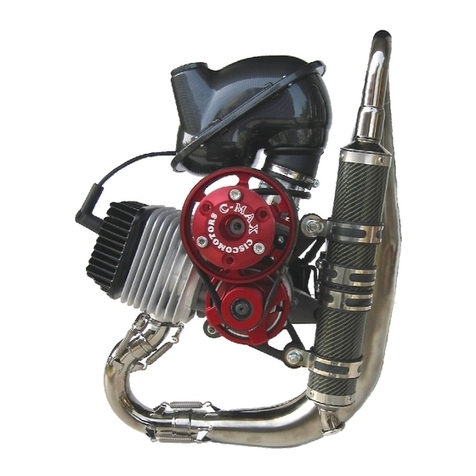
Ciscomotors
Ciscomotors C-Max Simplified maintenance manual
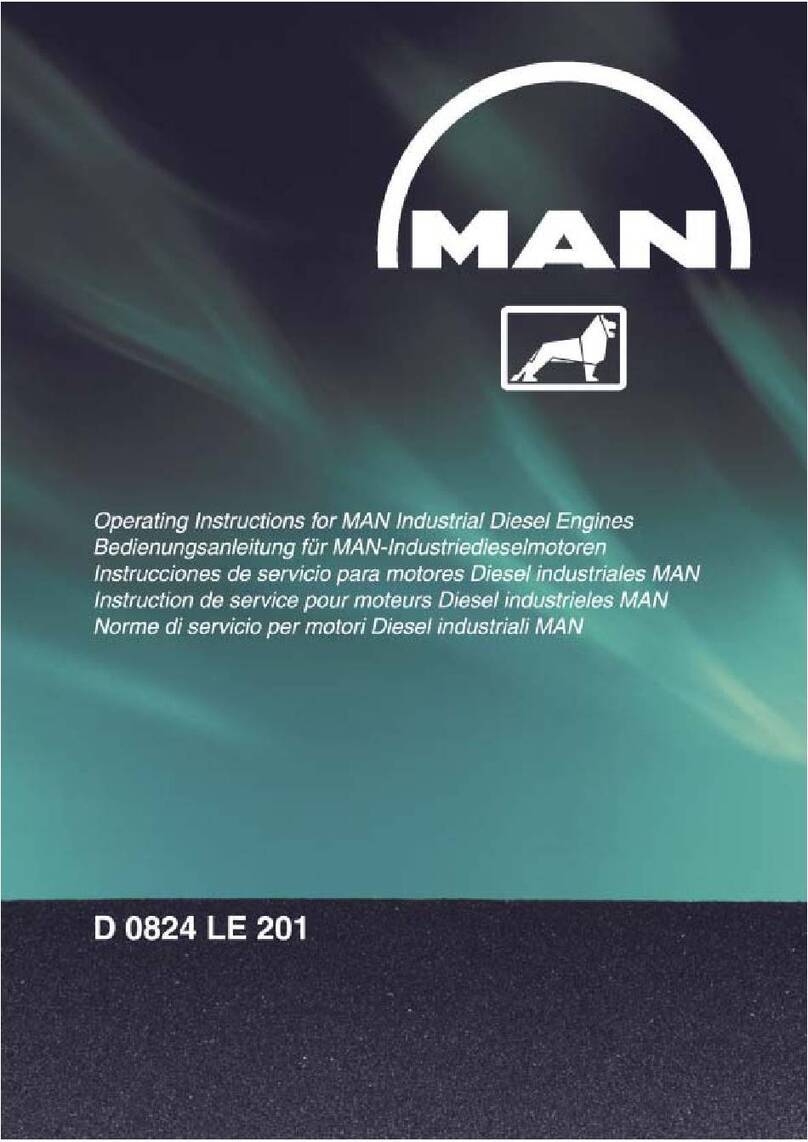
Man
Man D 0824 LE 201 operating instructions
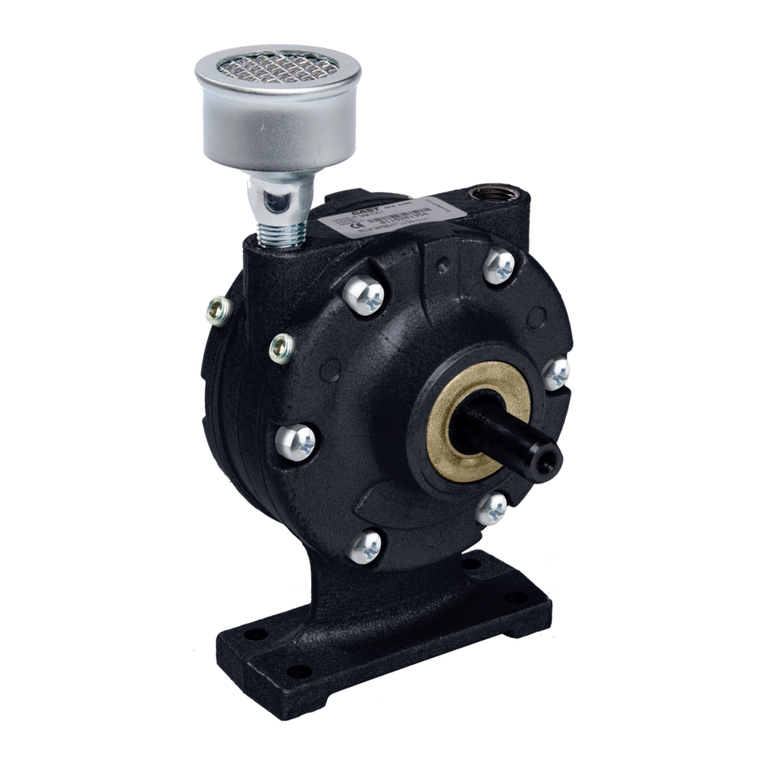
Idex
Idex Gast 4AM Series Operation and maintenance manual
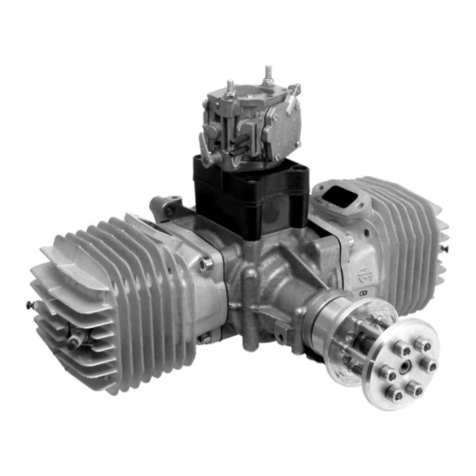
3W
3W 200i B2 TS manual
